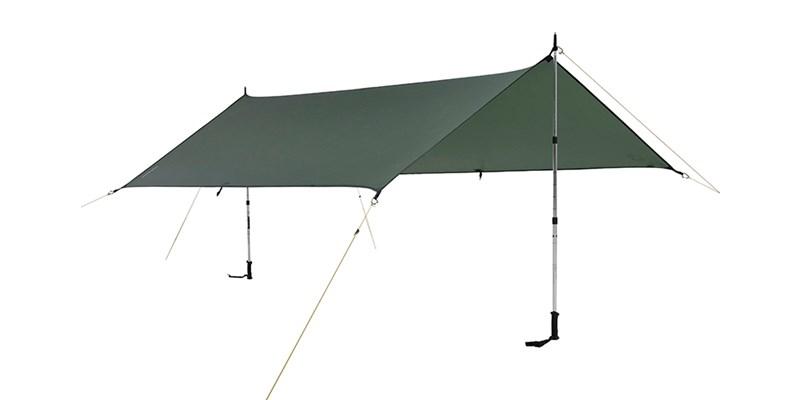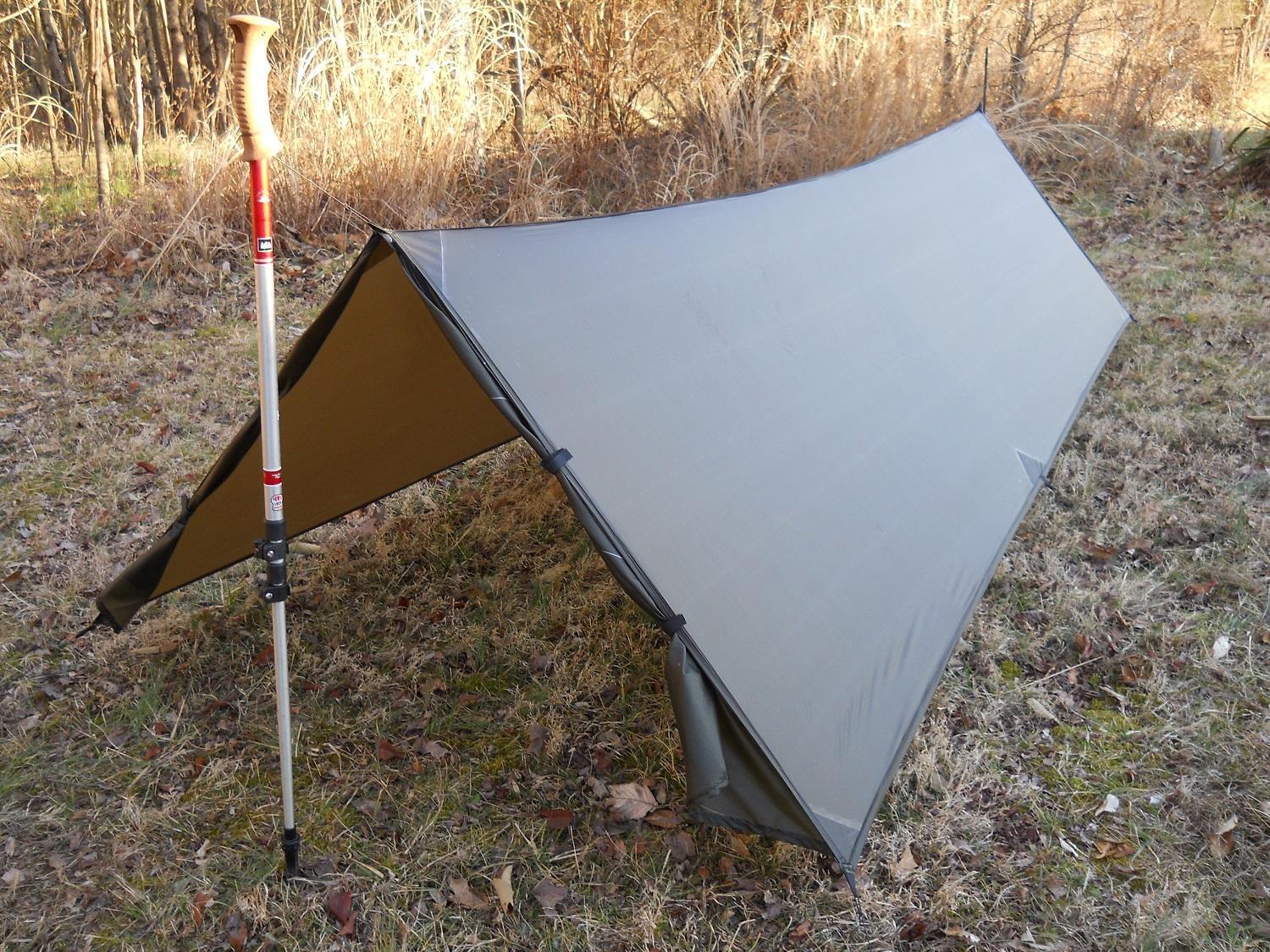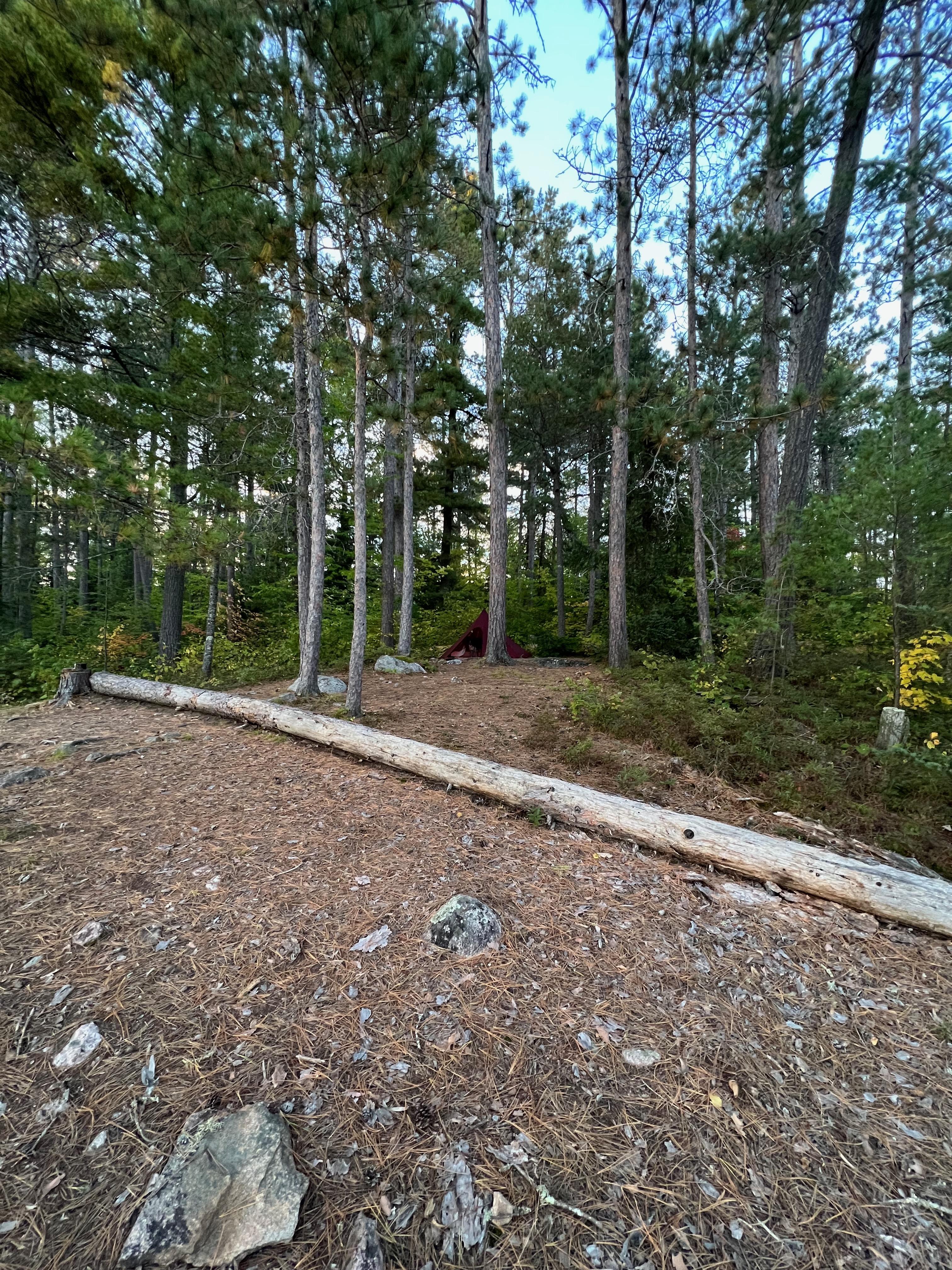Topic
Tarp fabric resistant to hail and extreme weather
Forum Posting
A Membership is required to post in the forums. Login or become a member to post in the member forums!
Home › Forums › Gear Forums › Gear (General) › Tarp fabric resistant to hail and extreme weather
- This topic has 114 replies, 24 voices, and was last updated 2 years, 3 months ago by
 Sam Farrington.
Sam Farrington.
-
AuthorPosts
-
Nov 20, 2022 at 3:42 am #3765685
Nice pics Jon. I wish I could get my hands on some of that 10D silnylon from ROK. Sam and I have discussed cannibalizing high quality materials from finished tarps for our projects on other threads. When I get my Christmas bonus I’m thinking about buying a couple of Nordisk Voss 5 tarps in order to get enough material for a cat cut solo tarp. Something I can carry on SUL fastpacking trips. Somehow the Scandinavians just seem to source the best materials. The Voss 5 is a 10D sil/sil 6.6 and the tarp is basically just two 147 cm wide panels bonded with a seam in the middle (perpendicular to ridgeline), so easy harvesting. https://nordisk.eu/voss-5-lw/forest-green/p/769/3691

Below is a smaller 270 cm long, 174 cm wide (head) and 140 cm wide (foot) cat cut solo tarp with zippered front doors I made last year out of RSBTR 7d MTN silnylon 6.6. The tarp pitches drum tight when dry, but when it gets wet it wilts and really loses its composure. I now want to make one a little wider out of some super high quality 10D silnylon. Of course the Hilleberg Tarp 5 features their Kerlon 1000 20D silnylon (Yellow Label), however it would be harder to salvage panels from the Tarp 5 than it would be the Nordisk flat tarp. And the 20D is just a tad heavy for what I want to do.
 Nov 20, 2022 at 5:00 am #3765687
Nov 20, 2022 at 5:00 am #3765687Monte, that tarp you made certainly looks sweet when dry and taut. I’ve heard negative reviews of the 7D from RBTR on account of the stretch; your experience confirms that. Nice to know.
Harvesting material from 2 Nordisk tarps would be expensive but certainly allow you to make exactly what you want. Thanks for the link, I hadn’t noticed that Nordisk was using that material to make tarps. Funny thing is that the dimensions of the tarp itself aren’t listed on the Nordisk site, only the packed dimensions.
Did you consider the Slingfin Splitwing? It sounds like it might be very close to what you want at a fraction of the price.
Nov 20, 2022 at 7:13 am #3765695Per usual ultralightoutdoorgear.co.uk provides more detailed info on gear than just about any other source. And of course they weigh every single item and then break down the weights of each component. The Voss 5 measures 200 cm X 250 cm and only weighs 170 g without lines. https://ultralightoutdoorgear.co.uk/voss-5-ulw-tarp/#Specifications I would imagine prices are cheaper on the Continent though because anything not made in the UK seems to be higher on UK gear sites.
Yes I really like the Splitwing Jon, but I am committed to a stealthy green color for all of my shelters now. I do a lot of hikes in the Eastern US where it’s often hard to tell where public lands end and private lands begin, so I like to do my wild camping in a way that goes unnoticed. Also I see that the Splitwing has 30D tieout reinforcements on a 10D tarp. They are pros at Slingfin and they obviously know far more than an amateur like myself, however I like my reinforcements to be the same material as the panels so as to stretch in the same exact manner. I’ve now gone to no sewing on the reinforcements and just bonding with Permatex Flowable silicone and I haven’t had any failures yet. Also the Splitwing is just a tad wider than what I want for stealth. I’m going for about 200 cm wide on front and 150 cm wide foot end.
I did a cat cut only on the ridgeline (tarp in pic above) and then later I went back and also did a cat cut on the long sides, which really made the tarp even tighter. Next project I’m going to do mild cat cuts on front and back ends as well as the ridgeline and not on the long sides, but rather just make the sides a tad shorter than ridgeline to make for a tauter pitch.
Nov 20, 2022 at 7:37 am #3765702The burgundy red wouldn’t have been my first choice for the 10D silnylon I used but there was no other choice. Turns out that it’s a lot more low key when seen from a distance than I would have thought:
 Nov 20, 2022 at 7:40 am #3765704
Nov 20, 2022 at 7:40 am #3765704Slingfin are adding green/brown versions of the Portal, so maybe that will make its way into a revised Splitwing. Lot of users seem to feel that the mesh inner needs a design revision.
Personally, I would shy away from a white colored shelter fabric, too.
Nov 20, 2022 at 5:05 pm #3765735Since we’re talking about tents shredding in hailstorms, what is your opinion on whether a tent in a hailstorm should still be pitched super tight, like you would for wind? or might having some slight slack decrease the likelihood of hail damage? I’m interested in silnylon performance.
Nov 20, 2022 at 5:08 pm #3765736Very good Q.
I always pitch my tents fairly tight. They have been through hail, and while it can be a (huge) worry, I think the stretch in the silnylon handles the impacts with some ease. That nylon fabric is actually very strong. I have never had hail damage.
My 2c.
CheersNov 21, 2022 at 12:53 am #3765749In the real world, I don’t think I’ve ever encountered hail that wasn’t accompanied by strong gusts of wind, at least (and especially) at the beginning of the hailstorm. The whole dynamic of updrafts that produces hail is basically a form of strong wind, isn’t it?
Even the best silnylons still have some elasticity when they’ve been pitched taut.
I would always pitch sil shelters taut under any circumstances.There is a discussion to be had, however, about pitching shelters too tight, though. While siliconized fabrics don’t have the same low low low threshold as DCF for permanent deformation, they, too, can permanently deform. This may be more of a problem with some types of silnylon than others (Bell’s Law: don’t generalize!).
Nov 21, 2022 at 5:24 pm #3765888Monte, re: “Sam: how do you know that Lightheart Gear source their 30D silnylon from Korea?”
Judy Gross, the owner, so informed me, but they were switching to silpoly, and had only a limited amount of the Korean nylon; but there was no discussion of denier, or ‘D’. It is easier for me to go by the finished weight of the fabric . One of the gurus at BPL once posted that denier is the best guide to finished weight. Not so sure about that, and will discuss in a moment.
First, though, please note that from their websites the tarps from Nordisc and Vango are either 70D (Vango) or nylon, or even cotton (Nordisc). Talk about mission creep. Although Roger has some silnylon, purchased probably before eco regs, and with more ‘composure’ when wet, the silnylons manufactured nowadays ‘lose their composure’ when wet (great term hah-hah for getting soaked in your tent). That’s why Roger has the bungee cords on the front stake loops.
As I’ve been posting, Yama uses a 20D silpoly that comes in at less than 1.1 osy, finished weight, which since 20D’s run 1.2 osy and up, suggests that denier is not a reliable guide to finished weight. I have enough of the Yama for a tent, but it took some time because they are very often out of stock (no surprise). Normally there would be concern about loose weave with the abnormally light 20D, but the weave is tight and there is also the mini-ripstop. Using the pouch-squeeze test, I could not force any water through it.
The issue you might have is the color, slate grey, and the owner reminded me that trying to dye a silcoated fabric with RIT DyeMore is very likely a really bad idea with silicone. Might try it, though, but only on a tiny scrap. A light green is nice; but the Yama fabric is by far the best I’ve seen for anything under 1.1 osy. At least it’s not black, or its popular alter ego, “dark olive,” which looks black to me. Bet a slate gray tent will be just as camouflaged as a green one. So slate it must be, because safety comes first, and it’s taken way too long to find the right fabric and get going on the construction. Did have plenty of time to think about the construction though.
So the silpoly Pelican Tarp I was going to fabric test today arrived, and it took only a pouch-squeeze test to produce a nice spray that could sub for the broken sprayer on the sink. There were plenty of drops too. But the Black Friday price was right, and that’s why I would never pay to cut up a Hilleberg, which is also nylon, no matter how much they fancy it up. And am glad the right fabric has been found, from a functional standpoint, even though the tarps cost a total of around $450. The slate gray won’t clash too much with the rocks, the total weight should be under 28 oz, and I’ll be dry and snug. Happy Thanksgiving.
P.S. Air also pushes easily through the the gossamer Pelican tarp. Maybe I’ll use it instead of the beefier 1.13 osy GoLite WPB for the inner tent ceiling, and drop another few ounces. It might withstand a few minutes of hard rain, which is enough for a rainy pitch and will hold the shape of the inner tent until the fly goes on and is tightened over the ceiling. It’s a lighter greenish color too, and would be pleasant to look at overhead.
Nov 21, 2022 at 5:47 pm #3765889Although Roger has some silnylon, purchased probably before eco regs, and with more ‘composure’ when wet,
Just so.
The EPA ‘killed’ the coating plant Westmark were using because the plant had no emissions controls, or means of collecting the solvent vapours given off by the silicone coating. The plant did not want to upgrade: too expensive.My suspicion at the time was that the coating process moved to Asia simply because the Asian countries had no regs on this. Do they have any emissions controls today? I don’t know. I wonder. I doubt.
Air also pushes easily through the the gossamer Pelican tarp.
The mind boggles. That is definitely not a ‘waterproof’ fabric! Yeah, it might serve quite well as a breathable inner tent.Cheers
Nov 21, 2022 at 6:06 pm #3765891So Roger,
You nixed the waterproof breathable GoLite, and the Pelican only “might’ serve.’ Must boggle some more.
Nov 21, 2022 at 7:09 pm #3765892The Pelican ‘might’ serve
Because I have not seen the fabric. So only ‘might’.nixed the waterproof breathable GoLite
I did? When was that? I don’t remember.
Besides, if the fabric is genuinely waterproof, I seriously doubt it is going to be very ‘breathable’. OK, GTX is slightly, but the rest . . .
My inner tent is an UNcoated (neither silicone nor PU) fabric, but it may have some DWR. Not sure, but I don’t rely on it.Cheers
Nov 21, 2022 at 11:44 pm #3765937Roger,
Many would like the inner to go up with the outer, like two dancers doing the same dance. Invested a lot of time with this, but was not comfortable with the mechanics of it, because I want to be able to eyeball all the moving parts as the tent is pitched. Especially in torrential rain with the wind blasting. Signs suggest that we will be seeing more of that due to climate change.
But first, I have to suck up the cost of the tarp that you also opined was clearly not waterproof, and test the WPB GoLight material to see if it is truly both waterproof and vapor permeable as advertised.. That was easy to do with eVent, but haven’t seen any of that lately, nor is it super light.
It would be a change to have an inner slightly heavier than the outer fly; but they will both be quite light, 1.08 osy for the fly, and 1.13 osy for the slightly smaller inner, which will use less fabric. Those are finished weights. So we’ll see if condensation on the inner can be prevented; partly because there is space between the inner and outer layers, and partly because water vapor will pass through the inner to the outer layer. And, if the outside of the inner by itself will resist water penetration long enough for the pitch, which I’m more sure about, because the tent is designed to shed water, the exposure is short, and GoLight fabric was one of the fabrics first HH tested by Richard Nisley on BPL. Que sera, sera.
Nov 22, 2022 at 1:44 am #3765938Many would like the inner to go up with the outer,
All of my winter tents do that: ‘integral pitch’ I think it is called. That works very well for a tunnel; I don’t know about others.I want to be able to eyeball all the moving parts as the tent is pitched.
Strangely enough, I sort of do this with my tunnels. Peg windward end out, insert poles while flat on ground, pull on lee end and shake so the whole tent pops up – and with the lee door slightly open I can see inside as I do this, withOUT getting rain on the groundsheet. This works fine in really bad weather, and it lets me get the lee end ‘square’ to the windward end straight off – no creases in the groundsheet.if condensation on the inner can be prevented; partly because there is space between the inner and outer layers, and partly because water vapor will pass through the inner to the outer layer.
This is more complex. Under benign conditions the water vapour does go through the fabric of the inner tent to any of blow out downwind / condense on the inside of the fly / condense and turn into ice on the inside of the fly. It depends . . .Under really cold conditions however the inner tent can get sub-zero, so the insensible sweat from our bodies condenses overnight into ice crystal on the inside of the inner tent. When that happens (when, not if) I sit up very carefully, avoiding brushing my head against the ice crystals. A lack of caution here means ice crystals down the back of my neck. One learns fast!
I do remember waking up one night in bad weather because my face was – well, ‘prickling’? Very strange sensation. That turned out to be tiny ice crystals shaken off the inner tent falling onto my face. The solution was to pull the hood of my quilt over my head and go back to sleep. The ice crystals either fell off or evaporated off: they were not there in the morning.
Cheers
Nov 22, 2022 at 12:39 pm #3765987There was an early article on BPL by Alan Dixon that at the time was a primer on waterproof breathables:
https://backpackinglight.com/00316-2/At the time, it was fairly clear that the best WPB’s could work fairly well on a jacket, but not so clear with respect to tents. The “Epic Malibu” fabric used by Black Diamond for tents was really a fabric treatment, and received a number of negative reports in posts on BPL. Black Diamond changed to a different WPB. Roger tested some of the original fabric for me and the results were also negative, and it was a heavy fabric, around 1.9 osy.
Since then Goretex has touted many advances, but it remains unclear how it will function on tents, not to mention just as an inner wall to prevent condensation. So am not sure how the lighter GoLite WPB will function. It’s waterproof enough because it was harvested from a poncho and should resist and repel water during a rainy pitch; but don’t know how it will handle moisture from condensation inside a tent. The GoLite product page stated that the poncho tarp was, “The ultimate in lightweight versatility. A shelter, waterproof breathable rain top and bottom, and pack cover combined.” Before cutting it up to make an inner, will devise some tests to see how it does with condensation..
-
AuthorPosts
- You must be logged in to reply to this topic.
Forum Posting
A Membership is required to post in the forums. Login or become a member to post in the member forums!
Trail Days Online! 2025 is this week:
Thursday, February 27 through Saturday, March 1 - Registration is Free.
Our Community Posts are Moderated
Backpacking Light community posts are moderated and here to foster helpful and positive discussions about lightweight backpacking. Please be mindful of our values and boundaries and review our Community Guidelines prior to posting.
Get the Newsletter
Gear Research & Discovery Tools
- Browse our curated Gear Shop
- See the latest Gear Deals and Sales
- Our Recommendations
- Search for Gear on Sale with the Gear Finder
- Used Gear Swap
- Member Gear Reviews and BPL Gear Review Articles
- Browse by Gear Type or Brand.






